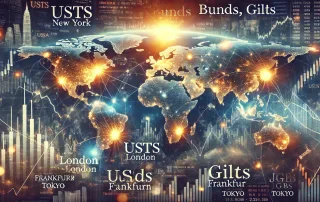Trump’s Tariff Threats Shake Forex Markets—Hidden Insights Revealed

How Trump’s Tariffs Shook the Forex Market: Unseen Trends
How do you make sense of a market that changes faster than the weekend plans of your friends? Well, strap in, because we’re diving into the chaos unleashed by Trump’s latest tariff threats against Canada, Mexico, and China—and how it sent traders on a wild ride through the currency jungle. Spoiler alert: there’s more happening here than meets the eye.
The Dollar Index (DXY) initially spiked like a trader seeing unexpected profits, riding the wave of Trump’s latest tariff threats against our neighbors to the North, South, and across the Pacific. The Canadian dollar (CAD), Mexican peso (MXN), and offshore yuan (CNH) were hit like a kid caught taking an extra cookie. But hold on—things took an interesting turn. The greenback’s gains began to unravel throughout the session. Why? Traders knew the real game wasn’t about tariffs alone, but about positioning ahead of upcoming data releases and the Fed’s latest moves. It’s like a party where everyone’s waiting for the host (the Fed) to make the big announcement before deciding whether to stay or leave.
Euro’s Rollercoaster Ride
EUR/USD had its own drama to deal with. After a decent gain, the euro pulled a “false summit” move—slipping back beneath the 1.0500 mark as the dollar firmed up. European Central Bank (ECB) officials were busy chatting, with Nagel hinting at cautious optimism over inflation—sounds hopeful, right? But don’t get too excited just yet. He warned that rate cuts need to be gradual, which translated means: “We’re keeping the champagne corked for now.”
GBP/USD’s Disappointing Comeback
The pound had a similar story. GBP/USD failed to keep its spot above 1.2600, falling back after Trump’s tariff comments. And just to rub salt in the wound, the UK’s Shop Price Index dipped further. Imagine the disappointment of getting knocked out twice in a fight you thought you’d win. Yeah, that’s kind of the vibe here.
JPY Slips Under Pressure
USD/JPY quietly trickled lower throughout the session, breaking below 154.00. The surprise culprit here? Firmer-than-expected Services Producer Price Index (PPI) data. It’s like JPY saw a “free drink” sign but noticed it was actually a bait-and-switch—not what anyone had in mind.
Antipodeans Bouncing Back, Kind Of
Trump’s tariff rant didn’t spare the Antipodeans. The Aussie and Kiwi dollars were left scrambling as CNH weakened. But here’s a twist—they rebounded off their worst levels. If you picture someone falling off a chair and then standing up, dusting themselves off, only to realize there’s no real reason to celebrate—that’s pretty much the situation here. A quiet economic calendar kept things from getting any more exciting, and now everyone is eagerly awaiting the Reserve Bank of New Zealand’s (RBNZ) next move.
The PBoC Twist: A Subtle Signal
The People’s Bank of China (PBoC) set the USD/CNY mid-point at 7.1910, lower than expected, which seemed to say, “Chill, we got this.” It was an understated move, but one that has implications for anyone watching the yuan closely—indicating they aren’t willing to let things get too out of hand despite the tariff turmoil.
What’s the Hidden Lesson Here?
So, what’s a Forex trader to do in all this chaos? The key is to understand the ripple effect: tariffs impact currencies directly involved, but the real action comes in the broader market reaction. The DXY initially took off, but savvy traders realized this was no time for unchecked optimism—especially with key economic data and the Fed lurking around the corner. It’s like knowing when to leave the party before things get weird.
Trump’s tariff threats make headlines, but smart traders look beyond the noise—watching for changes in momentum, digging into PBoC’s rate tweaks, and figuring out what the ECB’s cautious optimism means for the next rate cycle. This isn’t about making a quick buck. It’s about thinking two steps ahead—about having a trading plan that takes into account the bigger picture.
Remember, the best moves aren’t the ones everyone is talking about—they’re the ones you see coming before the noise reaches the rest of the market.
The Takeaway for Traders
- Tariffs create headline risk but look beyond the knee-jerk reactions.
- Watch central bank commentary closely—their cautious optimism can signal upcoming shifts.
- Always have a plan. Whether it’s tariffs or unexpected economic data, a solid strategy will keep you ahead of the crowd.
For those who want to stay ahead of the game, be sure to check out StarseedFX’s services:
- Latest Forex News: Stay updated on market moves at StarseedFX News.
- Forex Education: Learn in-depth techniques at StarseedFX Courses.
- Join Our Community: Access insider analysis and tactics at StarseedFX Community.
—————–
Image Credits: Cover image at the top is AI-generated

Anne Durrell
About the Author
StarseedFX delivers timely Forex news and market insights, thoughtfully edited and curated by Anne Durrell. As a seasoned Forex expert with over 12 years of industry experience, Anne turns complex market shifts into clear, engaging, and easy-to-understand updates.
From decoding the latest trends to writing her own in-depth analyses, Anne ensures every piece is both informative and enjoyable. If you found this article helpful, don’t forget to share it with fellow traders and friends, and leave a comment below—your insights make the conversation even richer! Follow StarseedFX for fresh updates and stay ahead in the dynamic world of Forex trading.






